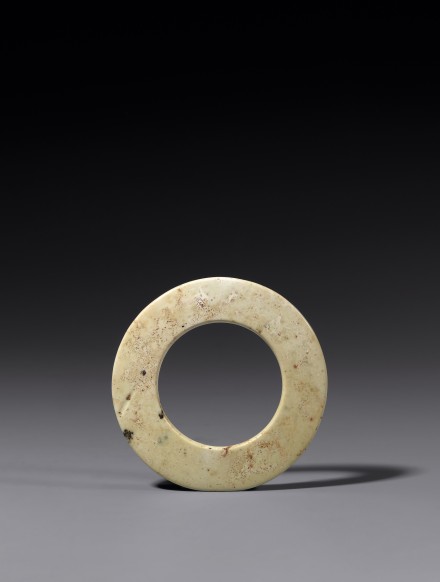J.J. Lally & Co., Oriental Art / New York City, New York
Menu
16.
A WHITE JADE FLAT RING (HUAN)
Neolithic Period, circa 5000 – 2000 B.C.
of plain form with wide central aperture, the cream white jade with cloudy beige mottling and a few dark gray natural inclusions, the sides slightly thicker at the center and tapering to the rounded rim, the smooth polished surface with encrusted earth.
Diameter 4 3⁄8 inches (11.2 cm)
Similar jade rings of this flattened form with wide central aperture have been discovered at several Neolithic sites in China, dating from as early as circa 5000 B.C. to circa 1600 B.C. Compare, for example, the jade flat ring of the same size with similar cloudy mottled surface excavated from Wushan county, Chongqing, Sichuan province, illustrated by Gu (ed.) in Zhongguo chutu yuqi quanji (Complete Collection of Jades Unearthed in China), Vol. 13, Sichuan and Chongqing, Beijing, 2005, p. 215, described as Daxi culture (circa 4400-3300 B.C.).
Compare also the similar jade flat rings of slightly smaller size excavated in Jiangsu province and now in the collection of the Nanjing Museum, illustrated in Zhongguo yuqi quanji (Compendium of Chinese Jades) Vol. 1, Primitive Society, Shijiazhuang, 1992, pp. 86-87, nos. 121 and 123, described as Songze culture (circa 4000-2500 B.C.).
Two slightly smaller jade rings of flattened form excavated in Gansu province are illustrated by Gu (ed.), Zhongguo chutu yuqi quanji (Complete Collection of Jades Unearthed in China), Vol. 15, Gansu, Qinghai, Ningxia, Xinjiang, Beijing, 2005, pp. 14-15, described as Qijia culture (circa 2250-1900 B.C.).
新石器時代 玉環 徑 11.2 厘米
16.
A WHITE JADE FLAT RING (HUAN)
Neolithic Period, circa 5000 – 2000 B.C.
Diameter 4 3⁄8 inches (11.2 cm)